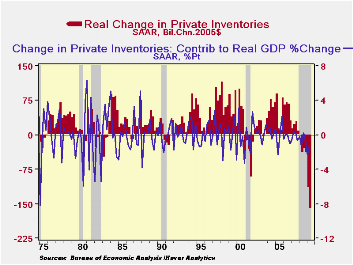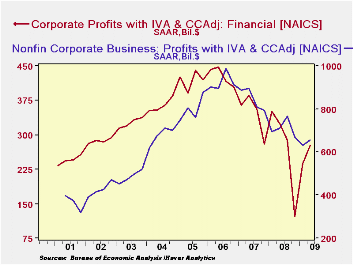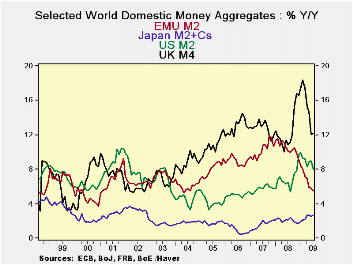 Global| Aug 27 2009
Global| Aug 27 2009Q2 GDP Unrevised on Net at 1.0% Fall; Hesitant Profits Recovery Continues
Summary
The pace of real GDP change was unchanged in today's report from the Commerce Department, which showed a 1.0% rate of decline. Inventories were revised lower but offset in the GDP tally by a smaller decline in domestic final sales and [...]
 The pace of
real GDP change was unchanged in today's report from the Commerce
Department, which showed a 1.0% rate of decline. Inventories
were revised lower but offset in the GDP tally by a smaller decline in
domestic final sales and a larger push from net exports than were
reported in the July release. Notably, these latter two
revisions put total final sales up at a 0.4% rate, the first quarterly
increase in a year.
The pace of
real GDP change was unchanged in today's report from the Commerce
Department, which showed a 1.0% rate of decline. Inventories
were revised lower but offset in the GDP tally by a smaller decline in
domestic final sales and a larger push from net exports than were
reported in the July release. Notably, these latter two
revisions put total final sales up at a 0.4% rate, the first quarterly
increase in a year.
This GDP report marks the initiation of new nomenclature by the Commerce Department for the order of the GDP releases. Formerly, the "advance" report was followed by the "preliminary". Now the report after the "advance" is called "second release" and will be followed next month by the "third release". Surely this is an improvement for the last here, formerly known as "final", but which was revised soon enough yet again in annual and comprehensive revisions, so it was hardly "final".
Among categories of
demand, revisions were generally modest and favorable.
Consumer spending is now estimated to have fallen at a 1.0% annual rate
compared to 1.2% before and residential investment is down at a 22.8%
pace instead of  the 29.3% reported earlier. Exports were
revised to a 5.0% decline from 7.0% before, and government consumption
and gross investment was increased to 6.4% growth from 5.6%.
On the downside, nonresidential investment was lowered to a 10.9% rate
of decline from 8.9% reported before, with the cut coming from
structures; equipment outlays were lifted a bit. Imports
remained down at a 15.1% rate, as goods imports were "more weak" and
service imports were "less weak".
the 29.3% reported earlier. Exports were
revised to a 5.0% decline from 7.0% before, and government consumption
and gross investment was increased to 6.4% growth from 5.6%.
On the downside, nonresidential investment was lowered to a 10.9% rate
of decline from 8.9% reported before, with the cut coming from
structures; equipment outlays were lifted a bit. Imports
remained down at a 15.1% rate, as goods imports were "more weak" and
service imports were "less weak".
The inventory reductions are even more impressive than they were in the earlier report. Previously seen at $141.1 billion SAAR in chained 2005 dollars, the new data show them at -$159.2 billion. Every major stage of distribution cut stocks sharply: manufacturers, wholesalers and retailers. We often attribute such major adjustments to the auto industry, and it certainly participated, but durable and nondurable goods wholesalers and "other" retailers also reduced their merchandise on hand. This said, the contribution of inventory change to the GDP decline was not as severe, 1.4%, as it had been in Q1, 2.4%.
One
reason to cut inventories -- and labor forces, for that matter -- is to
cut costs. The performance of profits indicates that progress
has been made on this front. Corporate profits in Q2 rose
5.7% pre-tax, including IVA and CCAdj, from Q1 and were below Q2 2008
by "just" 10.9%. The year-to-year movement in Q1 had been
-19.0% with -25.1% in Q4. By broad sector, financial industries saw their quarterly profits gain 16.7% in
Q2 from Q1; they had nearly doubled from Q4 to Q1, gaining
95.1%. On a year-to-year basis, financial company profits are
still down, with Q2 at -14.3%; on this 4-quarter trend, profits have
declined continuously since Q3 2006. Nonfinancial company
profits have contracted less consistently, although they continued a
quarter-to-quarter decline in Q1, down 6%. Q2 saw a partial
reversal to an increase 4.5%. The year-to-year trend remains
down, by 7.7% in Q2; this has been negative since Q2 2007.
Thus, these operating profits are beginning to recover, but with such
hesitation that might not yet inspire much confidence.
sector, financial industries saw their quarterly profits gain 16.7% in
Q2 from Q1; they had nearly doubled from Q4 to Q1, gaining
95.1%. On a year-to-year basis, financial company profits are
still down, with Q2 at -14.3%; on this 4-quarter trend, profits have
declined continuously since Q3 2006. Nonfinancial company
profits have contracted less consistently, although they continued a
quarter-to-quarter decline in Q1, down 6%. Q2 saw a partial
reversal to an increase 4.5%. The year-to-year trend remains
down, by 7.7% in Q2; this has been negative since Q2 2007.
Thus, these operating profits are beginning to recover, but with such
hesitation that might not yet inspire much confidence.
The
U.S. National Income & Product Account data are available in
Haver's USECON and the USNA
databases.
| Chained 2005$, % AR | 2Q '09 (2nd Release) | 2Q '09 (Advance) | 1Q '09 | 2Q Y/Y | 2008 | 2007 | 2006 |
|---|---|---|---|---|---|---|---|
| GDP | -1.0 | -1.0 | -6.4 | -3.9 | 0.4 | 2.1 | 2.7 |
| Inventory Effect | -1.4 | -0.8 | -2.4 | -1.0 | -0.4 | -0.4 | 0.1 |
| Final Sales | 0.4 | -0.2 | -4.1 | -2.9 | 0.8 | 2.5 | 2.6 |
| Foreign Trade Effect | 1.6 | 1.4 | 2.6 | 0.9 | -1.2 | 0.8 | 0.1 |
| Domestic Final Demand | -1.2 | -1.5 | -6.4 | -3.8 | -0.4 | 1.7 | 2.5 |
| Chained GDP Price Index | 0.0 | 0.2 | 1.9 | 1.5 | 2.1 | 2.9 | 3.3 |
by Robert Brusca August 27, 2009

The chart exhibits growth rates for money presented in
national currency terms for several key countries. The table produces
the same data with some different horizons for calculation. In the
chart’s lower panel, the various series are inflation-adjusted (real
balances).
Monetary expansions looks too strong - The
picture on Yr/Yr money growth is a bit frightening. Japan’s growth rate
for M2 plus CD’s, its preferred monetary measure, is at 2.7% and is
quite contained. EMU’s rate at 5.5% seems high for its current growth
state. At 8.1% and 12% respectively the US and the UK seem to have
flooded their respective markets with liquidity. And in some ways they
have.
Or is it decelerating too much? But if you
turn your attention to the table instead of the chart you see a second
phenomenon is in play. Money growth rates are and have been
decelerating greatly from 12-months to 6-months and from 6-months to
3-months. In addition we provide some credit measures for EMU and they
have the same properties.
Weak once inflation adjusted - Next if we
turn to the lower panel of the chart to focus on the inflation adjusted
flows there, we find a marked deceleration is in place and that
monetary growth appears to be much less aggressive than it seems on the
broader 12-month horizon and in a nominal framework.
EMU - In EMU 3-Month growth rates for
money are at 2% while credit to residents is rising in real terms at a
1% rate and loans are shrinking by nearly 1% in real terms.
US and UK: Despite double-digit 12-month
growth rates in both the US and the UK each has real money balances
shrinking over three months.
Japan: Only Japan has relatively stable
nominal rates of growth for money and a slightly expanded growth rate
for real money balances over three months.
Policy confusion: All this just adds to the
confusion about policy. Is it tight or is it loose? Is it as loose as
it seems over 12 months or is it being tightened too rapidly as the
3-month trend seems to say? What about extracting ourselves from this
overtly stimulative period? Is there inflation risk and can the central
banks handle it?
Crosscurrents -On balance we see lots of
opinions but few good ways to make a clear discriminating argument. We
prefer to point out that the situation is complicated and in flux. We
urge investors to weigh the issues and we believe that where you come
down on the central bank issue depends on if you have trust in the
central bank/bankers or not. We do not think that the data are very
clear or that any course of action is baked in the cake. We see the
excessive money growth followed by some too-hard squeezing as evidence
that the central bankers are managing the risks – or trying to do so.
After all, the Yr/Yr money supplies are bloated but that is what the
bankers did to help blunt the crisis. It is in the past. To balance
that we do not see explosive sequential growth rates for money, quite
the opposite. We do not think this is a coincidence. Just as we are
monitoring these flows, so the central bankers are monitoring the
economy and the monetary trends. The data in the table are good
remainders to be careful about only looking at Yr/Yr growth rates. That
Yr/Yr growth in US and UK money supplies looks a lot different when you
shorten the growth horizon and deflate the flows to adjust for the
effects of inflation.
| Look at Global and Euro Liquidity Trends | |||||||
|---|---|---|---|---|---|---|---|
| Saar-all | Euro Measures (E13): Money & Credit | G-10 Major Markets: Money | Memo | ||||
| €€-Supply M2 | Credit: Residents |
Loans | $US M2 | ££UK M4 | ¥¥Jpn M2+Cds | OIL:WTI | |
| 3-MO | 1.8% | 0.6% | -1.1% | 3.2% | 3.1% | 2.7% | 171.5% |
| 6-MO | 2.7% | -0.8% | -1.9% | 2.7% | 2.4% | 3.4% | 136.3% |
| 12-MO | 5.5% | 3.0% | 0.9% | 8.1% | 12.1% | 2.7% | -52.0% |
| 2-Yr | 7.8% | 7.0% | 5.1% | 7.3% | 11.5% | 2.4% | -6.6% |
| 3-Yr | 8.8% | 8.4% | 6.9% | 6.8% | 12.1% | 2.3% | -4.7% |
| Real Balances: deflated by Own CPI. Oil deflated by US CPI | |||||||
| 3-MO | 2.0% | 0.9% | -0.8% | -0.2% | -0.6% | 5.1% | 162.5% |
| 6-MO | 2.5% | -1.0% | -2.1% | 0.5% | -0.9% | 4.7% | 131.3% |
| 12-MO | 6.2% | 3.7% | 1.6% | 10.1% | 10.2% | 4.9% | -51.1% |
| 2-Yr | 6.1% | 5.3% | 3.3% | 5.5% | 8.2% | 2.4% | -8.2% |
| 3-Yr | 7.0% | 6.6% | 5.1% | 4.8% | 9.2% | 2.3% | -6.5% |
| Japan CPI for July is an estimate; it uses the June value to produce the real balance figure | |||||||
Carol Stone, CBE
AuthorMore in Author Profile »Carol Stone, CBE came to Haver Analytics in 2003 following more than 35 years as a financial market economist at major Wall Street financial institutions, most especially Merrill Lynch and Nomura Securities. She has broad experience in analysis and forecasting of flow-of-funds accounts, the federal budget and Federal Reserve operations. At Nomura Securites, among other duties, she developed various indicator forecasting tools and edited a daily global publication produced in London and New York for readers in Tokyo. At Haver Analytics, Carol is a member of the Research Department, aiding database managers with research and documentation efforts, as well as posting commentary on select economic reports. In addition, she conducts Ways-of-the-World, a blog on economic issues for an Episcopal-Church-affiliated website, The Geranium Farm. During her career, Carol served as an officer of the Money Marketeers and the Downtown Economists Club. She has a PhD from NYU's Stern School of Business. She lives in Brooklyn, New York, and has a weekend home on Long Island.





